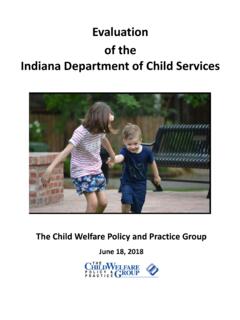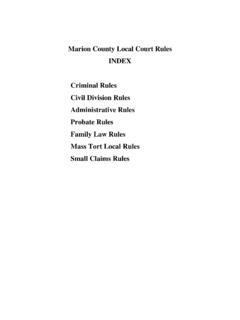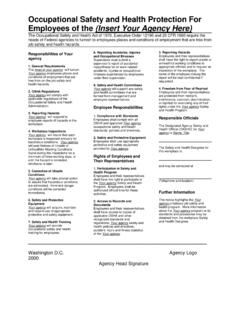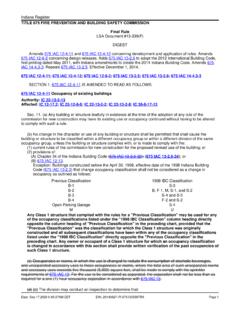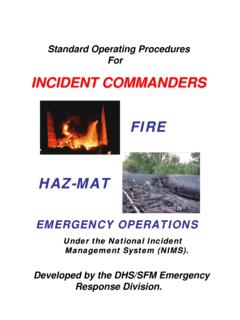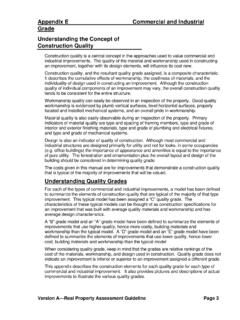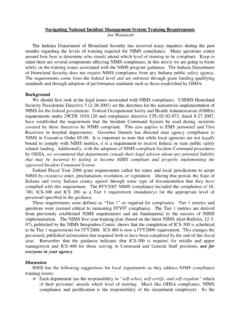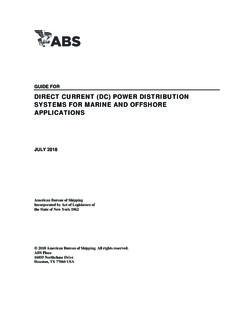Transcription of CHAPTER 6H. TYPICAL APPLICATIONS Section 6H.01 ... - Indiana
1 2011 IMUTCD Page 641 November 2011 Sect. CHAPTER 6H. TYPICAL APPLICATIONS Section TYPICAL APPLICATIONS Support: 01 CHAPTER 6G contains discussions of TYPICAL TTC activities. This CHAPTER presents TYPICAL APPLICATIONS for a variety of situations commonly encountered. While not every situation is addressed, the information illustrated can generally be adapted to a broad range of conditions. In many instances, an appropriate TTC plan is achieved by combining features from various TYPICAL APPLICATIONS . For example, work at an intersection might present a near-side work zone for one street and a far-side work zone for the other street. These treatments are found in two different TYPICAL APPLICATIONS , while a third TYPICAL application shows how to handle pedestrian crosswalk closures. For convenience in using the TYPICAL application diagrams, Tables 6C-1 and 6C-4 are reproduced in this CHAPTER as Tables 6H-3 and 6H-4, respectively.
2 02 Procedures for establishing TTC zones vary with such conditions as road configuration, location of the work, work activity, duration of work, road user volumes, road vehicle mix (buses, trucks, cars, motorcycles, and bicycles), and road user speeds. 03 In general, the procedures illustrated represent minimum solutions for the situations depicted. Except for the notes (which are clearly classified using headings as being Standard, Guidance, Option, or Support), the information presented in the TYPICAL APPLICATIONS can generally be regarded as Guidance. Option: 04 Other devices may be added to supplement the devices and device spacing may be adjusted to provide additional reaction time or delineation. Fewer devices may be used based on field conditions. Support: 05 Figures and tables found throughout Part 6 provide information for the development of TTC plans. Also, Table 6H-3 is used for the determination of sign spacing and other dimensions for various area and roadway types.
3 06 Table 6H-1 is an index of the 46 TYPICAL APPLICATIONS . TYPICAL APPLICATIONS are shown on the right hand page with notes on the facing page to the left. The legend for the symbols used in the TYPICAL APPLICATIONS is provided in Table 6H-2. In many of the TYPICAL APPLICATIONS , sign spacings and other dimensions are indicated by letters using the criteria provided in Table 6H-3. The formulas for determining taper lengths are provided in Table 6H-4. 07 Most of the TYPICAL APPLICATIONS show TTC devices for only one direction. Page 642 2011 IMUTCD Sect. November 2011 Table 6H-1. Index to TYPICAL APPLICATIONS TYPICAL Application Description TYPICAL Application Number Work Outside of the Shoulder (see Section ) Work Beyond the Shoulder TA-1 Blasting Zone TA-2 Work on the Shoulder (see Sections and ) Work on the Shoulders TA-3 Short Duration or mobile Operation on a Shoulder TA-4 Shoulder Closure on a Freeway TA-5 Shoulder Work with Minor Encroachment TA-6 Work Within the Traveled Way of a Two-Lane Highway (see Section 0)
4 Road Closed with a Diversion TA-7 Roads Closed with an Off-Site Detour TA-8 Overlapping Routes with a Detour TA-9 Lane Closure on a Two-Lane Road Using Flaggers TA-10 Lane Closure on a Two-Lane Road with Low Traffic Volumes TA-11 Lane Closure on a Two-Lane Road Using Traffic control Signals TA-12 Temporary Road Closure TA-13 Short Term or Short Duration Work in a Roundabout TA-13AY Haul Road Crossing TA-14 Work in the Center of a Road with Low Traffic Volumes TA-1 5 Surveying Along the Center Line of a Road with Low Traffic Volumes TA-16 mobile Operations on a Two-Lane Road TA-1 7 mobile Operations on a Two-Lane Road Using Flaggers TA-17AY Work Within the Traveled Way of an Urban Street (see Section 1) Lane Closure on a Minor Street TA-1 8 Detour for One Travel Direction TA-1 9 Detour for a Closed Street TA-20 Work Within the Traveled Way at an Intersection and on Sidewalks (see Section 3) Lane Closure on the Near Side of an Intersection TA-21 Right-Hand Lane Closure on the Far Side of an Intersection TA-22 Left-Hand Lane Closure on the Far Side of an Intersection TA-23 Half Road Closure on the Far Side of an Intersection TA-24 Multiple Lane Closures at an Intersection TA-25 Closure in the Center of an Intersection TA-26 Closure at the Side of an Intersection TA-27 Sidewalk Detour or Diversion TA-28 Crosswalk Closures and Pedestrian Detours TA-29 Work Within the Traveled Way of a Multi-Lane, Non-Access Controlled Highway (see Section )
5 Interior Lane Closure on a Multi-Lane Street TA-30 Work on a Dual-Left Turn Lane TA-30AY Lane Closure on a Street with Uneven directional Volumes TA-31 Half Road Closure on a Multi-Lane, High-Speed Highway TA-32 Lane Shift on a Road with a Dual-Left Turn Lane TA-32AY Stationary Lane Closure on a Divided Highway TA-33 Lane Closure with a Temporary Traffic Barrier TA-34 mobile Operation on a Multi-Lane Road TA-35 mobile Operation on Multiple Lanes of a Multi-Lane Road TA-35AY Work Within the Traveled Way of a Freeway or Expressway (see Section 4) Lane Shift on a Freeway TA-36 Double Lane Closure on a Freeway TA-37 Interior Lane Closure on a Freeway TA-38 Median Crossover on a Freeway TA-39 Median Crossover for an Entrance Ramp TA-40 Median Crossover for an Exit Ramp TA-41 Work in the Vicinity of an Exit Ramp TA-42 Partial Exit Ramp Closure on the Right-Hand SIde TA-43 Partial Exit Ramp Closure with Work in the Gore Area TA-43AY Work in the Vicinity of an Entrance Ramp TA-44 Temporary Reversible Lane Using Movable Barriers TA-45 Work in the Vicinity of a Grade Crossing (see Section ) Work in the Vicinity of a Grade Crossing TA-46 2011 IMUTCD Page 643 November 2011 Sect.
6 Table 6H-2. Meaning of Symbols on TYPICAL Application Diagrams High-level warning device (Flag tree) Longitudinal channelizing device Luminaire Pavement markings that should be removed for a long-term project Table 6H-3. Meaning of Letter Codes on TYPICAL Application Diagrams Road Type Distance Between Signs** A B C Urban (low speed)* 100 feet 100 feet 100 feet Urban (high speed)* 350 feet 350 feet 350 feet Rural 500 feet 500 feet 500 feet Expressway / Freeway 1,000 feet 1,500 feet 2,640 feet * Speed category to be determined by highway agency ** The column headings A, B, and C are the dimensions shown in Figures 6H-1 through 6H-46. The A dimension is the distance from the transition or point of restriction to the first sign. The B dimension is the distance between the first and second signs. The C dimension is the distance between the second and third signs.
7 (The first sign is the sign in a three-sign series that is closest to the TTC zone. The third sign is the sign that is furthest upstream from the TTC zone.) Table 6H-4. Formulas for Determining Taper Length Speed (S) Taper Length (L) in feet 40 mph or less L = WS2 60 45 mph or more L = WS Where: L = taper length in feet W = width of offset in feet S = posted speed limit, or off-peak 85th-percentile speed prior to work starting, or the anticipated operating speed in mph Shadow vehicle Sign (shown facing left) Surveyor Temporary barrier Temporary barrier with warning light Traffic or pedestrian signal Truck-mounted attenuator Type 3 barricade Warning light Work space Work vehicle Arrow board Arrow board support or trailer (shown facing down) Changeable message sign or support trailer Channelizing device Crash cushion Direction of temporary traffic detour Direction of traffic Flagger Page 644 2011 IMUTCD Sect.
8 November 2011 Notes for Figure 6H-1 TYPICAL Application 1 Work Beyond the Shoulder Guidance: 1. If the work space is in the median of a divided highway, an advance warning sign should also be placed on the left side of the directional roadway. Option: 2. The ROAD WORK AHEAD sign may be replaced with other appropriate signs such as the SHOULDER WORK sign. The SHOULDER WORK sign may be used for work adjacent to the shoulder. 3. The ROAD WORK AHEAD sign may be omitted where the work space is behind a barrier, more than 24 inches behind the curb, or 15 feet or more from the edge of any roadway. 4. For short-term, short duration or mobile operation, all signs and channelizing devices may be eliminated if a vehicle with activated high-intensity rotating, flashing, oscillating, or strobe lights is used. 5. Vehicle hazard warning signals may be used to supplement high-intensity rotating, flashing, oscillating, or strobe lights.
9 Standard: 6. Vehicle hazard warning signals shall not be used instead of the vehicles high-intensity rotating, flashing, oscillating, or strobe lights. 2011 IMUTCD Page 645 November 2011 Sect. Figure 6H-1. Work Beyond the Shoulder (TA-1) Note: See Tables 6H-2 and 6H-3 for the meaning of the symbols and/or letter codes used in this figure. TYPICAL Application 1 Page 646 2011 IMUTCD Sect. November 2011 Notes for Figure 6H-2 TYPICAL Application 2 Blasting Zone Standard: 1. Whenever blasting caps are used within 1,000 feet of a roadway, the signing shown shall be used. 2. The signs shall be covered or removed when there are no explosives in the area or the area is otherwise secure. 3. Whenever a side road intersects the roadway between the BLASTING ZONE AHEAD sign and the END BLASTING ZONE sign, or a side road is within 1,000 feet of any blasting cap, similar signing, as on the mainline, shall be installed on the side road.
10 4. Prior to blasting, the blaster in charge shall determine whether road users in the blasting zone will be endangered by the blasting operation. If there is danger, road users shall not be permitted to pass through the blasting zone during blasting operations. Guidance: 5. On a divided highway, the signs should be mounted on both sides of the directional roadways. 2011 IMUTCD Page 647 November 2011 Sect. Figure 6H-2. Blasting Zone (TA-2) TYPICAL Application 2 1,000 ft or less1,000 ft zone1,000 to500 ftNote:= Blasting cap Blasting area See Tables 6H-2 and 6H-3 for the meaning of the symbols and/or letter codes used in this figure. 300 to 500 ft 1,000 ft 300 to 500 ft Page 648 2011 IMUTCD Sect. November 2011 Notes for Figure 6H-3 TYPICAL Application 3 Work on the Shoulders Guidance: 1. A SHOULDER WORK sign should be placed on the left side of the roadway for a divided or one-way street only if the left shoulder is affected.
